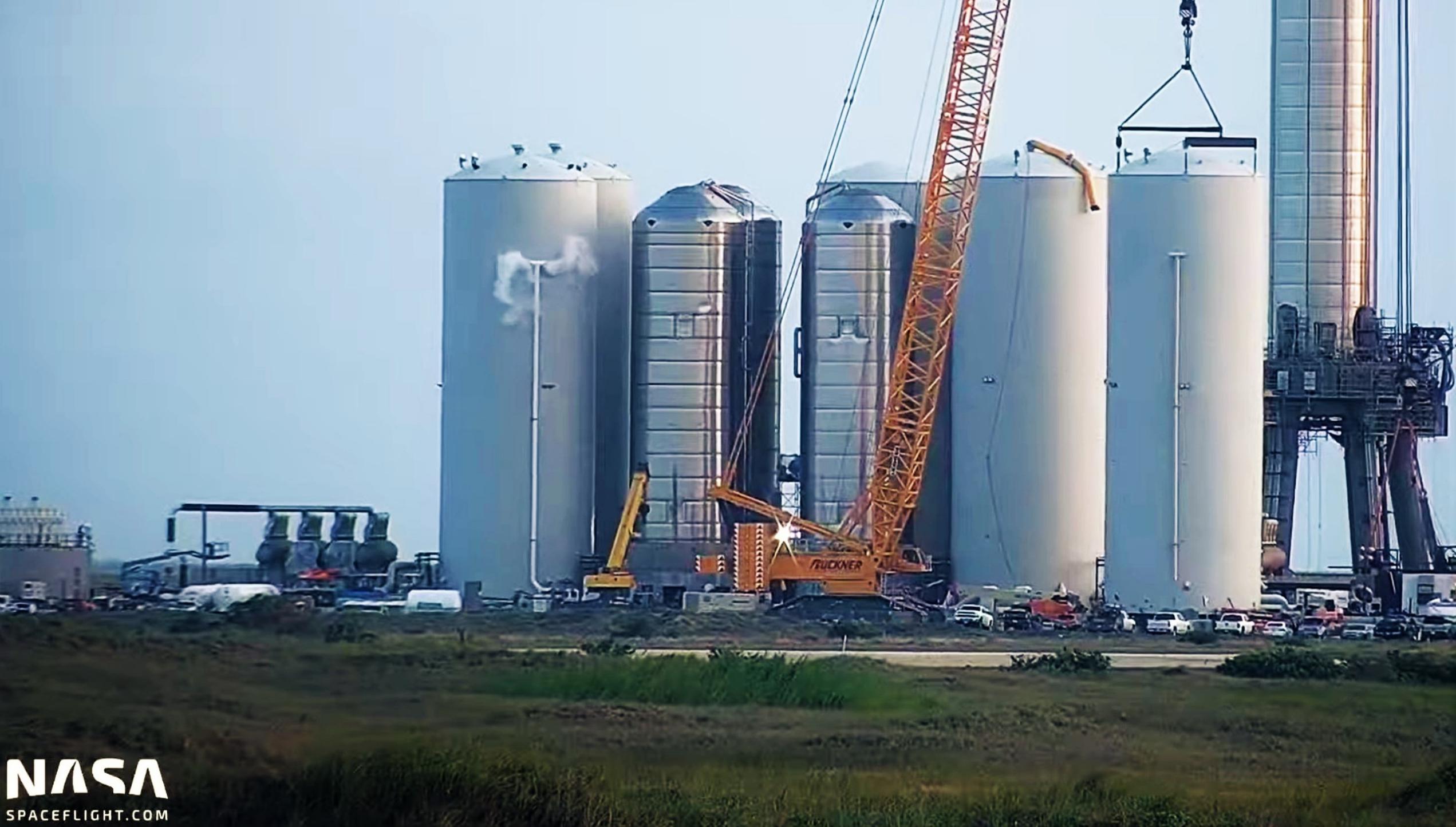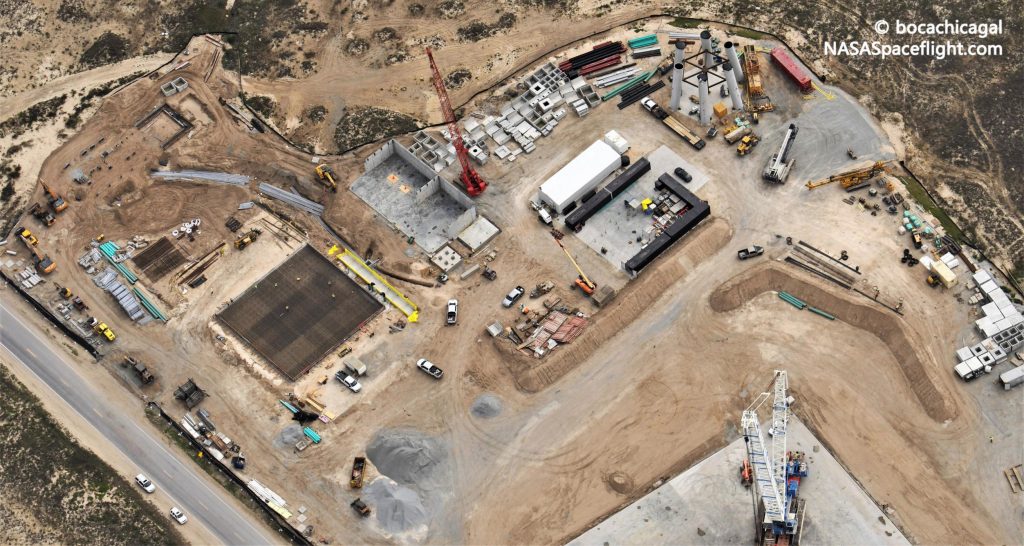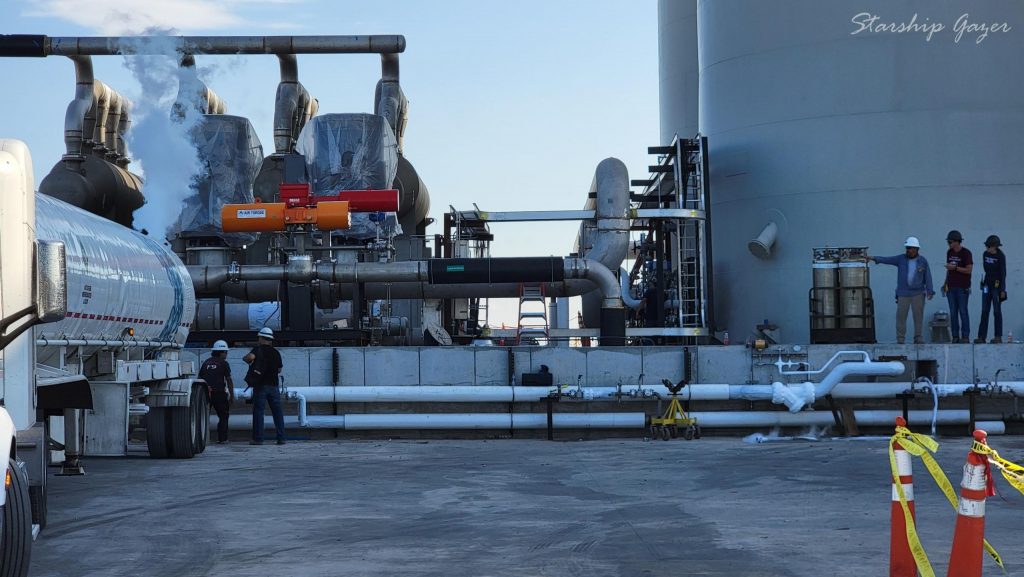

News
SpaceX’s orbital Starship launch pad tank farm comes to life for the first time
Update: Two days after a bevy of tanker trucks began to arrive at SpaceX’s orbital Starship launch site with load upon load of cryogenic liquid nitrogen, the company’s custom-built tank farm appears to have taken its very first ‘breaths.’
In other words, at least one of seven massive propellant storage tanks – two of which appear to have been fully completed and insulated – began venting. For a tank like SpaceX’s ground support equipment (GSE) tanks, the level of venting observed can only mean one thing: pressure maintenance during operations with cryogenic fluids. As cryofluids are loaded into empty tanks, they inevitably come into contact with warm pipes and tank walls, rapidly warming a portion of the liquid that then boils into gas. Tanks then need to vent that excess gas to avoid bursting.
In the case of SpaceX’s two completed liquid oxygen GSE tanks and a spate of liquid nitrogen (LN2) deliveries this week, it’s clear that the company has begun the process of testing and activating part of its brand new orbital-class Starship tank farm – beginning with much less risky LN2 proof testing. Filling the two finished LOx tanks with LN2 should also serve the dual purpose of flushing and cleaning them of any debris or contaminants, ensuring that it’s safe to fill them with LOx when the time comes.
For the first time, SpaceX appears to have begun delivering large quantities of cryogenic fluids to Starship’s orbital launch pad – still under construction but fast approaching some level of initial operational capability.
Sometime in the morning on September 19th, a semi-truck carrying a cryogenic liquid nitrogen (LN2) transport trailer arrived at SpaceX’s Starbase launch facilities. Normally, that would be a completely mundane, uninteresting event: SpaceX has used and will continue to use liquid nitrogen to safely proof test Starship prototypes and supercool their liquid methane (LCH4) and oxygen (LOx) propellant for the indefinite future. However, up to now, 100% of all Starbase cryogen deliveries have gone to the suborbital launch site, where two “mounts” and a few concrete aprons have supported all Starship and Super Heavy tests and launches to date.
Instead, this particular LN2 tanker headed for Starbase’s first orbital tank farm and began to offload its cryogenic liquid cargo at a number of brand new fill stations specifically designed for the task.
Still well under construction and at least a few weeks or months from total complete, Starship’s orbital launch site tank farm will ultimately be a group of eight massive storage tanks surrounded by thousands of feet of insulated plumbing, industrial pumps, a small army of “cryocoolers,” a blockhouse filled with human-sized valves, and much more. Said tank farm has been under construction for the better part of 2021, beginning with work on its concrete foundation this January.
Nine months later, the orbital tank farm is nearly complete. A power distribution and communications blockhouse has been complete for weeks with virtually all the wiring and cabling needed for the orbital launch mount and tower already in place. Several hundred feet of concrete cable and plumbing conduit have been filled with thousands of feet of wires, cables, and pipes and been sealed and buried. The tank farm blockhouse – where a dozen or so massive valves control the flow of propellant to and from the orbital launch mount and tower – is complete save for some final plumbing.

Finally, seven of eight GSE (ground support equipment) tanks have been installed and partially plumbed. Built in the same factory, six are virtually identical to Starship and Super Heavy tanks and will store LOx (3x), LN2 (2x), LCH4 (2x), and around a million gallons of water. Save for one LCH4 tank, all have been installed at the farm and that last tank (known as GSE8) is nearly complete back at the build site. Additionally, to insulate those seven thin, steel storage tanks, SpaceX has contracted with a water/storage tank company to build seven “cryoshells” and said million-gallon water tank.
The water tank was installed months ago and all seven shells are completed and ready to go as of last month. Only two of those seven cryoshells have been installed – and, rather asymmetrically, both on LOx tanks. SpaceX recently rolled the first LN2 tank cryoshell to the farm and could install it soon but as of now, it will likely be weeks before the orbital tank farm will have sleeved, insulated LOx, LN2, and LCH4 tanks ready for testing.

At the moment, that’s one of the biggest points of uncertainty standing between SpaceX and the ability to test Super Heavy or Starship at the orbital launch site. It’s entirely unclear if uninsulated GSE tanks can support any kind of substantial testing – like, say, the first full Super Heavy static fire test campaign – before their contents effectively boil off. As such, it’s a bit of mystery why SpaceX then had at least three tanker loads of liquid nitrogen – likely more than 70 tons (~150,000 lb) total – delivered to the orbital tank farm on September 19th.
By all appearances the first time that the farm’s actual main tanks have been filled with anything, that liquid nitrogen seems to have been loaded into one or both of the two insulated LOx tanks. There are two or three main explanations. First, SpaceX could simply be testing those more or less completed tanks with their first cryogenic fluids. Those partial ‘cryo proof’ tests would also help clean and flush out the interior of the LOx tanks, removing mundane debris or contamination that could become a major hazard when submerged in a high-density oxidizer. Given that both tanks can easily hold ~1300 tons (~2.9M lb) of liquid nitrogen, 70 tons is more of a tickle than a test, though, so a magnitude more would need to be delivered to perform even a half-decent bare-minimum cryoproof.
The other distinct possibility is that SpaceX plans to temporarily use one or both of the only two finished orbital pad tanks to store liquid nitrogen for Super Heavy Booster 4’s first cryogenic proof test. Either way, SpaceX has test windows scheduled every day this week, beginning with a six-hour window that opens at 5pm CDT today (Sept 20). Stay tuned to find out what exactly SpaceX plans to test and if the orbital tank farm and its first taste of liquid nitrogen are involved!
News
Tesla begins Robotaxi certification push in Arizona: report
Tesla seems serious about expanding its Robotaxi service to several states in the coming months.

Tesla has initiated discussions with Arizona transportation regulators to certify its driverless Robotaxi service in the state, as per a recent report from Bloomberg News. The move follows Tesla’s launch of its Robotaxi pilot program in Austin, Texas, as well as CEO Elon Musk’s recent comments about the service’s expansion in the Bay Area.
The Arizona Department of Transportation confirmed to Bloomberg that Tesla has reached out to begin the certification process for autonomous ride-sharing operations in the state. While details remain limited, the outreach suggests that Tesla is serious about expanding its driverless Robotaxi service to several territories in the coming months.
The Arizona development comes as Tesla prepares to expand its service area in Austin this weekend, as per CEO Elon Musk in a post on X. Musk also stated that Tesla is targeting the San Francisco Bay Area as its next major market, with a potential launch “in a month or two,” pending regulatory approvals.
Tesla first launched its autonomous ride-hailing program on June 22 in Austin with a small fleet of Model Y vehicles, accompanied by a Tesla employee in the passenger seat to monitor safety. While still classified as a test, Musk has said the program will expand to about 1,000 vehicles in the coming months. Tesla will later upgrade its Robotaxi fleet with the Cyercab, a two-seater that is designed without a steering wheel.
Sightings of Cybercab castings around the Giga Texas complex suggests that Tesla may be ramping the initial trial production of the self-driving two-seater. Tesla, for its part, has noted in the past that volume production of the Cybercab is expected to start sometime next year.
In California, Tesla has already applied for a transportation charter-party carrier permit from the state’s Public Utilities Commission. The company is reportedly taking a phased approach to operating in California, with the Robotaxi service starting with pre-arranged rides for employees in vehicles with safety drivers.
News
Tesla sets November 6 date for 2025 Annual Shareholder Meeting
The automaker announced the date on Thursday in a Form 8-K.

Tesla has scheduled its 2025 annual shareholder meeting for November 6, addressing investor concerns that the company was nearing a legal deadline to hold the event.
The automaker announced the date on Thursday in a Form 8-K submitted to the United States Securities and Exchange Commission (SEC). The company also listed a new proposal submission deadline of July 31 for items to be included in the proxy statement.
Tesla’s announcement followed calls from a group of 27 shareholders, including the leaders of large public pension funds, which urged Tesla’s board to formally set the meeting date, as noted in a report from The Wall Street Journal.
The group noted that under Texas law, where Tesla is now incorporated, companies must hold annual meetings within 13 months of the last one if requested by shareholders. Tesla’s previous annual shareholder meeting was held on June 13, 2024, which placed the July 13 deadline in focus.
Tesla originally stated in its 2024 annual report that it would file its proxy statement by the end of April. However, an amended filing on April 30 indicated that the Board of Directors had not yet finalized a meeting date, at least at the time.
The April filing also confirmed that Tesla’s board had formed a special committee to evaluate certain matters related to CEO Elon Musk’s compensation plan. Musk’s CEO performance award remains at the center of a lengthy legal dispute in Delaware, Tesla’s former state of incorporation.
Due to the aftermath of Musk’s legal dispute about his compensation plan in Delaware, he has not been paid for his work at Tesla for several years. Musk, for his part, has noted that he is more concerned about his voting stake in Tesla than his actual salary.
At last year’s annual meeting, TSLA shareholders voted to reapprove Elon Musk’s compensation plan and ratified Tesla’s decision to relocate its legal domicile from Delaware to Texas.
Elon Musk
Grok coming to Tesla vehicles next week “at the latest:” Elon Musk
Grok’s rollout to Tesla vehicles is expected to begin next week at the latest.

Elon Musk announced on Thursday that Grok, the large language model developed by his startup xAI, will soon be available in Tesla vehicles. Grok’s rollout to Tesla vehicles is expected to begin next week at the latest, further deepening the ties between the two Elon Musk-led companies.
Tesla–xAI synergy
Musk confirmed the news on X shortly after livestreaming the release of Grok 4, xAI’s latest large language model. “Grok is coming to Tesla vehicles very soon. Next week at the latest,” Musk wrote in a post on social media platform X.
During the livestream, Musk and several members of the xAI team highlighted several upgrades to Grok 4’s voice capabilities and performance metrics, positioning the LLM as competitive with top-tier models from OpenAI and Google.
The in-vehicle integration of Grok marks a new chapter in Tesla’s AI development. While Tesla has long relied on in-house systems for autonomous driving and energy optimization, Grok’s integration would introduce conversational AI directly into its vehicles’ user experience. This integration could potentially improve customer interaction inside Tesla vehicles.
xAI and Tesla’s collaborative footprint
Grok’s upcoming rollout to Tesla vehicles adds to a growing business relationship between Tesla and xAI. Earlier this year, Tesla disclosed that it generated $198.3 million in revenue from commercial, consulting, and support agreements with xAI, as noted in a report from Bloomberg News. A large portion of that amount, however, came from the sale of Megapack energy storage systems to the artificial intelligence startup.
In July 2023, Musk polled X users about whether Tesla should invest $5 billion in xAI. While no formal investment has been made so far, 68% of poll participants voted yes, and Musk has since stated that the idea would be discussed with Tesla’s board.
-

 Elon Musk1 week ago
Elon Musk1 week agoTesla investors will be shocked by Jim Cramer’s latest assessment
-

 Elon Musk3 days ago
Elon Musk3 days agoElon Musk confirms Grok 4 launch on July 9 with livestream event
-

 Elon Musk18 hours ago
Elon Musk18 hours agoxAI launches Grok 4 with new $300/month SuperGrok Heavy subscription
-

 News7 days ago
News7 days agoTesla Model 3 ranks as the safest new car in Europe for 2025, per Euro NCAP tests
-

 Elon Musk2 weeks ago
Elon Musk2 weeks agoA Tesla just delivered itself to a customer autonomously, Elon Musk confirms
-

 Elon Musk1 week ago
Elon Musk1 week agoxAI’s Memphis data center receives air permit despite community criticism
-

 Elon Musk2 weeks ago
Elon Musk2 weeks agoTesla’s Omead Afshar, known as Elon Musk’s right-hand man, leaves company: reports
-

 News2 weeks ago
News2 weeks agoXiaomi CEO congratulates Tesla on first FSD delivery: “We have to continue learning!”

















